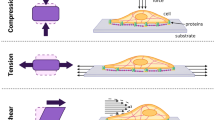Abstract
In most cell culture studies, cells are grown on smooth culture surfaces. Using microfabrication technology, we have developed microgrooved silicone surfaces to grow cells and subject them to repetitive mechanical stretching. When human patellar tendon fibroblasts were plated on these microgrooved surfaces, the cells had an elongated shape and underwent cyclic uniaxial stretching parallel to their long axes, all of which closely mimic conditions of tendon fibroblasts in vivo. Also, when fibroblasts were grown on microgrooves oriented at 45 and 90 degrees with respect to stretching direction, they did not change alignment or shape under cyclic mechanical stretching. Furthermore, compared to nonstretched cells, 8% cyclic stretching of tendon fibroblasts oriented at 0 (i.e., parallel to stretching direction), 45, and 90 degrees was found to increase α-SMA protein expression level by 46, 31, and 14%, respectively. In addition, 8% cyclic stretching tendon fibroblasts for 4 and 8 h oriented parallel to stretching direction increased α-SMA protein expression level by 25 and 57%, respectively. Thus, the results of this study showed that α-SMA protein expression levels of tendon fibroblasts depend on cell orientation with respect to stretching direction and stretching duration. We suggest that microgrooved silicone substrates can be used to study biological responses of tendon or ligament fibroblasts to repetitive mechanical stretching conditions in a more controlled manner.
Similar content being viewed by others
References
Arora, P. D., N. Narani, and C. A. McCulloch. The compliance of collagen gels regulates transforming growth factor-beta induction of alpha-smooth muscle actin in fibroblasts. Am. J. Pathol. 154:871–582, 1999.
Brunette, D. M. Fibroblasts on micromachined substrata orient hierarchically to grooves of different dimensions. Exp. Cell Res. 164:11–26, 1986.
Buck, R. C. Reorientation response of cells to repeated stretch and recoil of the substratum. Exp. Cell Res. 127:470–474, 1980.
Buckley, M. J., A. J. Banes, L. G. Levin, B. E. Sumpio, M. Sato, R. Jordan, J. Gilbert, G. W. Link, and R. Tran Son Tay. Osteoblasts increase their rate of division and align in response to cyclic, mechanical tension in vitro. Bone Miner. 4:225–236, 1988.
Carver, W., M. L. Nagpal, M. Nachtigal, T. K. Borg, and L. Terracio. Collagen expression in mechanically stimulated cardiac fibroblasts. Circ. Res. 69:116–122, 1991.
Chen, C. S., M. Mrksich, S. Huang, G. M. Whitesides, and D. E. Ingber. Geometric control of cell life and death. Science 276:1425–1428, 1997.
Clark, P., P. Connolly, A. S .Curtis, J. A. Dow, and C. D. Wilkinson. Topographical control of cell behaviour: II. Multiple grooved substrata. Development 108:635–644, 1990.
Darby, I., O. Skalli, and G. Gabbiani. Alpha-smooth muscle actin is transiently expressed by myofibroblasts during experimental wound healing. Lab. Invest. 63:21–29, 1990.
Dartsch, P. C., and H. Hammerle. Orientation response of arterial smooth muscle cells to mechanical stimulation. Eur. J. Cell Biol. 41:339–346, 1986.
Desmouliere, A., A. Geinoz, F. Gabbiani, and G. Gabbiani. Transforming growth factor-beta 1 induces alpha-smooth muscle actin expression in granulation tissue myofibroblasts and in quiescent and growing cultured fibroblasts. J. Cell Biol. 122:103–111, 1993.
Dunn, G. A., and A. F. Brown. Alignment of fibroblasts on grooved surfaces described by a simple geometric transformation. J. Cell Sci. 83:313–340, 1986.
Dunn, G. A., and J. P. Heath. A new hypothesis of contact guidance in tissue cells. Exp. Cell Res. 101:1–14, 1976.
Folkman, J., and A. Moscona. Role of cell shape in growth control. Nature 273:345–349, 1978.
Hung, C. T., and J. L. Williams. A method for inducing equi-biaxial and uniform strains in elastomeric membranes used as cell substrates. J. Biomech. 27:227–232, 1994.
Leung, D. Y., S. Glagov, and M. B. Mathews. A new in vitro system for studying cell response to mechanical stimulation. Different effects of cyclic stretching and agitation on smooth muscle cell biosynthesis. Exp. Cell Res. 109:285–298, 1977.
Mudera, V. C., R. Pleass, M. Eastwood, R. Tarnuzzer, G. Schultz, P. Khaw, D. A. McGrouther, and R. A. Brown. Molecular responses of human dermal fibroblasts to dual cues: Contact guidance and mechanical load. Cell Motil. Cytoskeleton 45:1–9, 2000.
Neidlinger-Wilke, C., E. S. Grood, J.-C. Wang, R. A. Brand, and L. Claes. Cell alignment is induced by cyclic changes in cell length: Studies of cells grown in cyclically stretched substrates. J. Orthop. Res. 19:286–293, 2001.
Neidlinger-Wilke, C., H. J. Wilke, and L. Claes. Cyclic stretching of human osteoblasts affects proliferation and metabolism: A new experimental method and its application. J. Orthop. Res. 12:70–78, 1994.
Ralphs, J. R., A. D. Waggett, and M. Benjamin. Actin stress fibres and cell-cell adhesion molecules in tendons: Organisation in vivo and response to mechanical loading of tendon cells in vitro. Matrix Biol. 21:67–74, 2002.
Schaffer, J. L., M. Rizen, G. J. L’Italien, A. Benbrahim, J. Megerman, L. C. Gerstenfeld, and M. L. Gray. Device for the application of a dynamic biaxially uniform and isotropic strain to a flexible cell culture membrane. J. Orthop. Res. 12:709–719, 1994.
Tomasek, J. J., G. Gabbiani, B. Hinz, C. Chaponnier, and R. A. Brown. Myofibroblasts and mechano-regulation of connective tissue remodelling. Nat. Rev. Mol. Cell. Biol. 3:349–363, 2002.
Wang, H., W. Ip, R. Boissy, and E. S. Grood. Cell orientation response to cyclically deformed substrates: Experimental validation of a cell model. J. Biomech. 28:1543–1552, 1995.
Wang, J., H. Chen, A. Seth, and C. A. McCulloch. Mechanical force regulation of myofibroblast differentiation in cardiac fibroblasts. Am. J. Physiol. Heart Circ. Physiol. 285:H1871–H1881, 2003.
Wang, J. H. Substrate deformation determines actin cytoskeleton reorganization: A mathematical modeling and experimental study. J. Theor. Biol. 202:33–41, 2000.
Wang, J. H., and E. S. Grood. The strain magnitude and contact guidance determine orientation response of fibroblasts to cyclic substrate strains. Connect Tissue Res. 41:29–36, 2000.
Wang, J. H., E. S. Grood, J. Florer, and R. Wenstrup. Alignment and proliferation of MC3T3-E1 osteoblasts in microgrooved silicone substrata subjected to cyclic stretching. J. Biomech. 33:729–735, 2000.
Author information
Authors and Affiliations
Corresponding author
Rights and permissions
About this article
Cite this article
Wang, J.HC., Yang, G. & Li, Z. Controlling Cell Responses to Cyclic Mechanical Stretching. Ann Biomed Eng 33, 337–342 (2005). https://doi.org/10.1007/s10439-005-1736-8
Received:
Accepted:
Issue Date:
DOI: https://doi.org/10.1007/s10439-005-1736-8




